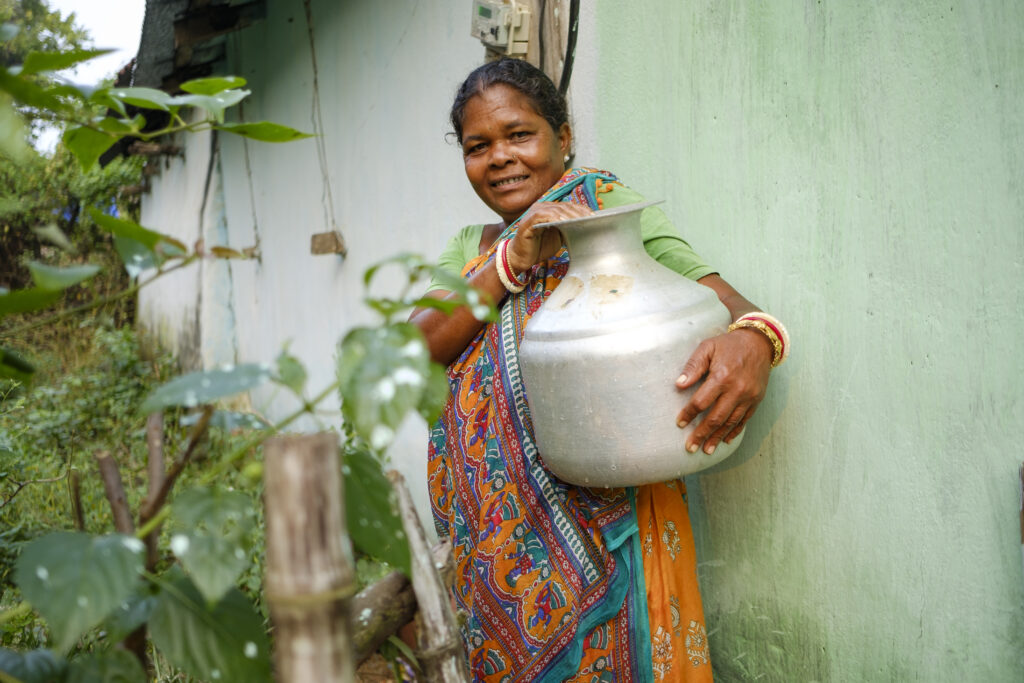By Vinay Harswal WRM Specialist, Water For People India
This blog was a finalist in our first Water For People blog competition among all of our colleagues around the globe. Congratulations Vinay!
Versión en español aquí.
A watershed is not simply the hydrological unit but also socio-political-ecological entity which plays crucial role in determining food, social, and economic security. The watershed development approach must be guided by principles of balance: whatever is drawn from mother earth must be returned, and sufficiency for all before superfluity for some. Watershed development reduces the volume and velocity of runoff through a series of interventions. The aim is to make the water walk, rather than letting it run. The simple methods of stalling rainwater from running off have an enormous positive impact on the overall health of the watershed.
What is a Watershed?
The area where a river "catches" its water is called its catchment or watershed. A watershed can be visualized as a landscape shaped unevenly like a bowl or basin. When it rains, water flows down from the top of this bowl to collect at the bottom. The undulating land area of any region forms several such units, each of which are called watersheds. Water within each of these units drains to a common point. So, the hills, valleys, forests, and fields that encircle the falling rain and guide it into streams and then rivers, all form the enclosure that is a watershed.
The top of a watershed from where the slopes start is called the ridge because it is the dividing line that partitions one watershed from another. The slopes falling from the ridge to the beginning of the plains make up the ridge area. The many channels through which rainwater flows are called drainage lines. Gullies, streams, and rivers – differentiated by the size of their catchment areas – are all drainage lines. The larger the expanse of land that collects and drains water into a channel, the bigger the stream of water will be. The size of a watershed may vary from a few hectares to thousands of square kilometers.
Watersheds can be defined at various levels. The water flowing through several gullies joins up to make a naali (a small stream), many naalis combine to make a naala (a larger stream), naalas flow into a nadi (a river), and so on. The smallest stream is called the first order stream. Two first order streams join to make a second order stream, two second order streams join to make a third order stream, and so on.
Watersheds are delineated from upstream to downstream. In India, 4,566 watersheds have been delineated from sub-basins. However, these watersheds can be further divided into a number of sub-watersheds and micro-watersheds. Sub-watersheds are mainly small tributaries or a group of contiguous small tributaries. Micro-watersheds are mostly naalas or a group of contiguous small local naalas.
Why Watershed Development?
Typically in India, rain falls very intensely within a few hours, within a few days, within a few months of every year. The number of rainy days does not average more than 40-50 days in most parts of the country. The challenge is to find ways of using this water where it falls. For more than 50 years, watershed planners across India have allowed the rain which falls in every village to flow out into the rivers as runoff and then try to bring this water back to the villages by building large and expensive dams and canal networks. The aim of watershed development is precisely to reverse this process, to stop and conserve water where it falls, within every village, under the direction of the village watershed committee, so that it can be used for a longer period. The objectives of watershed development programs are:
- Developing wastelands, degraded lands, drought-prone areas, and desert areas, keeping in view the capability of land, site conditions, and local needs.
- Promoting overall economic development and improving socioeconomic conditions of the poor and disadvantaged populations inhabiting program areas.
- Mitigating the adverse effects of extreme climatic conditions, such as drought and desertification, on crops, humans, and livestock.
- Restoring ecological balance by harnessing, conserving, and developing natural resources (i.e., land, water, and vegetative cover).
- Using a watershed approach for land development, water resources development, afforestation, and pasture development.
Watershed Development: How?
Soil and Water Conservation Practices
Soil and water conservation practices are at the heart of watershed development program. Conservation practices can be divided into two main categories:
- In-situ development: Land and water conservation practices, such as construction of contour bunds, graded bunds and field bunds, terrace building, broad bed and furrow practices, and other soil-moisture conservation practices are known as in-situ management. These practices protect land degradation, improve soil health, and increase soil-moisture availability and groundwater recharge.
- Ex-situ development: Construction of check dams, farm ponds, gully control structures, and pit excavation across the stream channel are practices known as ex-situ management. Ex-situ practices reduce peak discharge to reclaim gully formation and harvest substantial amounts of runoff, which increases groundwater recharge and irrigation potential in watersheds.
Watershed Development Action Plans
A meeting of the Gram Sabha or Ward Sabha is convened to prepare a village-level Action Plan for integrated watershed development, based on information generated from a benchmark survey of watershed areas and a detailed Participatory Rural Appraisal. The Gram Panchayat then prepares a detailed plan under the guidance of the Watershed Development Team and submits it to the Project Implementation Agency. The Action Plan contains the clear demarcation of the watershed, with specific survey numbers, ownership details, and a map depicting the location of proposed activities. Action Plans should be prepared for all arable and nonarable land, including degraded forestlands, government and community lands, and private lands and can include the following elements:
- Development of small water harvesting structures, such as low-cost farm ponds, naala bunds, check dams, percolation tanks and other ground water recharge measures.
- Renovation and augmentation of water sources, including desolated village tanks for drinking water, irrigation, or fisheries development.
- Afforestation, including block plantations, agroforestry and horticultural development, shelterbelt plantations, and sand dune stabilization.
- Land development, including in-situ soil and moisture conservation measures, bench terracing in hilly terrain, nursery rising for fodder, timber, fuel wood, horticulture, and non-timber forest product species.
- Drainage line treatment with a combination of vegetative and engineering structures.
- Repair, restoration, and upgrade of existing common property assets and water harvesting structures to obtain optimum and sustained benefits from previous public investments.
Capacity Building
Watershed development requires multiple interventions that jointly enhance the resource base and livelihoods of rural people. This requires capacity building of all stakeholders from farmers to policy makers. Lack of stakeholder knowledge of objectives, approaches, and activities can affect the performance of the watersheds. Capacity building focuses on construction of low-cost soil and water conservation methods, production and use of bio-fertilizers and bio-pesticides, income generating activities, livestock-based activities, waste land development, and market linkages. A clear understanding of strategic planning, monitoring, and evaluation related to watershed development is essential for government officials and policy makers. Trainings at different levels are organized to socialize various activities and their economic, social, and environmental benefits. This helps stakeholders make effective and efficient use of resources to achieve their own goals on a sustained basis.
Advantages of Watershed Development
Since watershed structures are designed to stall rainwater at regular intervals, runoff cannot gather speed, volume, or force. As a result:
- Soil erosion is reduced. Water does not gain enough momentum or force to scrape off topsoil.
- Silt is trapped. Silt carried by the water flow reaches a dead end when the water collects in small trenches and bunds. This, in turn, reduces the rate of silt piling up in water harvesting structures in the lower reaches of the watershed.
- Groundwater volume increases. By slowing down the flow of water on the surface, we increase the possibility of water percolating into the ground. This, in turn, raises the water table.
- The life of rivers and storages is prolonged. Water that has been caught in the ridge area trickles down slowly, increasing the duration of flow in the drainage lines. The capacity of the water harvesting structures created downstream are also utilized more fully as they refill more often.
- The local soil moisture profile improves. This provides greater sustenance to vegetation or biomass.
Conclusions
Through the watershed development, we can:
- Increase the groundwater resources.
- Address challenges related to water quantity and quality.
- Improve overall water resources management efforts.
- Include various stakeholders in action planning and implementation efforts.



